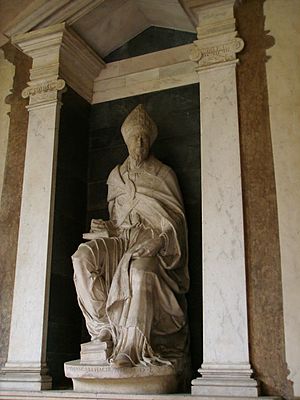Paolo Giovio facts for kids
Quick facts for kids Paolo Giovio |
|
|---|---|
| Bishop of Nocera de' Pagani | |

Paolo Giovio
|
|
| Church | Catholic Church |
| Diocese | Diocese of Nocera de' Pagani |
| In Office | 1528–1552 |
| Predecessor | Domenico Giacobazzi |
| Successor | Giulio Giovio |
| Orders | |
| Consecration | 17 Apr 1533 by Gabriele Mascioli Foschi |
| Personal details | |
| Born | 19 April 1483 Isola Comacina of Lake Como |
| Died | 11 December 1552 (aged 69) Florence |
Paolo Giovio (also known as Paulo Jovio) was an important Italian doctor, historian, and church leader. He was born on April 19, 1483, and passed away on December 11, 1552.
Contents
Early Life and Education
Paolo Giovio was born in Como, a city in Italy. His family came from Isola Comacina near Lake Como. His father, who was a notary (someone who makes legal documents), died when Paolo was about 17 years old.
Paolo was taught by his older brother, Benedetto Giovio, who was a humanist (someone who studies human culture, history, and philosophy). Even though Paolo was very interested in books and writing, he went to Padua to study medicine. He finished his medical studies in 1511.
Career as a Doctor and Historian
After finishing his studies, Giovio worked as a doctor in Como. But when a serious illness spread in the city, he moved to Rome in 1513.
In Rome, Pope Leo X gave him a special teaching job at the university. He taught about how people should live and think (Moral Philosophy) and later about nature and science (Natural Philosophy). The Pope also made him a knight. Around this time, Paolo started writing historical essays. He even wrote a special book about Pope Leo X soon after the Pope died.
In 1517, Giovio became the personal doctor for Cardinal Giulio di Giuliano de' Medici, who later became Pope Clement VII. Paolo wrote books about health and medicine. He even questioned some of the old ideas about medicine and thought it was more important to prevent sickness than just to cure it.
Giovio helped Pope Clement VII during a very difficult time for Rome in 1527. From 1526 to 1528, he stayed as a guest on the island of Ischia.
Becoming a Bishop
In 1528, Paolo Giovio became the bishop of Nocera de' Pagani, an important role in the church. He also wrote about a Russian ambassador named Dmitry Gerasimov who visited Pope Clement VII. In his writings, Giovio included many details about the geography of Muscovy (which is now Russia).
In 1536, Giovio had a beautiful house built for himself on Lake Como. He called it Museo, which means "Museum." He used this house to keep his large collection of portraits of famous soldiers and writers. He also collected old artifacts and items from the New World (the Americas). After Pope Clement VII died, Giovio decided to retire. Today, copies of the paintings from his collection, known as the Giovio Series, can be seen in the Uffizi Gallery in Florence.
Later Years and Death
In 1549, Pope Paul III did not give Giovio the title of Bishop of Como, which he had hoped for. So, Giovio moved to Florence, where he passed away in 1552.
Important Works

Paolo Giovio is best known for his important historical writings. His most famous work is Historiarum sui temporis libri XLV, which tells the history of his own time. He also wrote a collection of biographies called Vitae virorum illustrium (meaning "Lives of Famous Men") and Elogia virorum bellica virtute illustrium (meaning "Praise of Men Illustrious for Courage in War").
Giovio is especially remembered for writing about the Italian Wars. He was an eyewitness to many of the battles, and his accounts are a very important source of information for that period. He also wrote a lot about a famous Albanian hero named Skanderbeg.
He was also one of the first people to write a biography of the famous artist Raphael.
Some of Giovio's other notable works include:
- De romanis piscibus (1524) - About Roman fish.
- De legatione Basilii Magni Principis Moschoviae (1525) - About the Russian ambassador.
- Commentario de le cose de’ Turchi (1531) - About the Turks.
- Elogia virorum litteris illustrium or Elogia doctorum virorum (1546) - Praises of learned men.
- Descriptio Britanniae, Scotiae, Hyberniae et Orchadum (1548) - A description of Britain, Scotland, Ireland, and the Orkney Islands.
- Vitae (1549) - Biographies.
- Pauli Jovii historiarum sui temporis (1550–52) - His history of his own time.
- Elogia virorum bellica virtute illustrium (1554) - Praises of men famous for their courage in war.
- Dialogo dell'imprese militari et amorose (1555) - A dialogue about military and love symbols.
See also
 In Spanish: Paulo Jovio para niños
In Spanish: Paulo Jovio para niños

